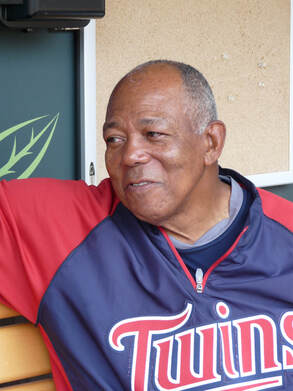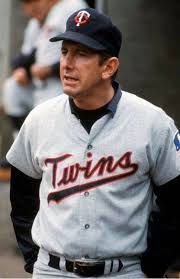
The year before Tony Oliva won the American League batting title as a rookie in 1964, he headed to Triple-A Dallas-Fort Worth after tearing the cover off the ball in spring training. He was upset when he didn’t make the Opening Day roster, and he soon discovered there were two unanticipated occupational hazards playing for that Triple-A club.
The team owned its own plane, a DC-3 aircraft, which had been in vogue in the 1940s. This particular plane had seen better days by the time Oliva, César Tovar, Sandy Valdespino and their teammates were flying between Triple-A destinations in the mid-1960s. Smooth flights were rare, with a few trips more alarming than others.
Oliva recalls two or three hair-raising flights that summer, including one between Dallas and Seattle, which had players wondering if they weren’t living out their final minutes. One of the plane’s engines developed a problem, and as the decrepit DC-3 sputtered, the pilots warned passengers that an emergency landing was a distinct possibility. The flight crew managed to land the plane without incident, but the white-knuckle affair had the young men contemplating their mortality with every turbulent hiccup and dip in altitude.
Even with both engines working properly, Valdespino says the players called the plane “the Knuckleball” for the way it danced and darted in the air. Even getting back on solid ground could generate anxiety, as one touchdown in particular took the phrase “hard landing” to new heights.
“I remember a time we were flying to Oklahoma City,” Oliva recalls. “We hit the runway so hard that the plane took off again. We had to go around and get in line to land again.” Jim Rantz, a promising pitching prospect in the early 1960s who went on to oversee the Twins’ minor league system, shared many of those scary airborne moments as Oliva’s teammate, including the crazy carom on the runway in Oklahoma City.
“It was, like, five in the morning, and the explanation was that the pavement was blacktop and it was so hot that the heat made the plane bounce,” Rantz explains with a heavy dose of skepticism. He notes the plane had more issues than overheated pavement. Weight was often a concern, and luggage and cargo had to be distributed evenly to keep the Knuckleball on course. Despite that concern, the players played a key role in the balancing act.
“The DC-3s were a plane where the tail sits almost on the ground,” Rantz recalls. “When you got on, you had to walk uphill. When the luggage rack would get filled up in the tail, the 25 players would make a human conveyor belt and we’d have to pass the equipment up the aisle to the front luggage. So we helped load the plane.” Whether it was a matter of weight or its distribution—or simply the age of the plane—Rantz says the DC-3 always struggled to gain altitude once it was in the air.
“I remember when we had to go to Denver,” says Lee Stange, who mostly pitched for the Twins that summer but made eight starts for Dallas. “We couldn’t get over the mountains, so we used to go in between them. That Denver flight was the scariest one to me. I’d sit up front behind the pilots. You could see the mountains coming at you.”
Before long, Oliva and Valdespino had to all but drag Tovar onto the plane for a road trip. Oliva remembers a time after that hellish Seattle flight when Tovar, approaching the plane, got down on his knees and pleaded, “Oh please, oh please, I got three kids in Venezuela. I don’t want to get on that plane!” Oliva often was at Tovar’s side at takeoff.
“A lot of times, Tony and César, you’d see them sitting in the back,” remembers Rantz. “They’d have the blankets over their heads when you’d take off, and they’d have it for the whole flight until you landed … I would get a little nervous when the copilot would come down the aisle and it’s the middle of the night. He’s got his flashlight and he’s leaning in front of you, looking at the wings. I said, ‘What are you doing?’ He said, ‘I’m just looking to see if we’re picking up any ice on the wings.’ Yeah, that’s not a comforting feeling.”
No one on the team liked to fly the Knuckleball. Lefthander Gerry Arrigo, who pitched parts of four seasons with the Twins, refused to even set foot on the aircraft. Oliva says Arrigo showed up for his initial team flight, vomited before boarding, and went home instead.
“I didn’t like to fly to begin with,” Arrigo says. “When they started weighing the players at the airport, that was it, I went home. I went back to Amelia, Ohio, and stayed there for a week or so. They called me and wanted to know why I went home. I told them why, and I said, ‘I’m not going to fly on that plane, period. Send me to a bus league if you want.’ So they sent me to Charlotte, and I played in the bus league there. I only played about 10 games and I was sent back to Minnesota.”
Another less-threatening but unavoidable hazard of playing in Dallas was the requirement to dress the part of a Texas rancher while on road trips. The players, traveling in Western clothing, leather boots and 10-gallon hats, were quite a sight walking through airports. Oliva could only laugh when he first saw Valdespino and Tovar, his Latin friends, in their Western duds. Valdespino says Tony O, amused by the getup they were forced to wear, called the trio the Black Cowboys.
—From “Tony Oliva: The Life and Times of a Minnesota Twins Legend”
The team owned its own plane, a DC-3 aircraft, which had been in vogue in the 1940s. This particular plane had seen better days by the time Oliva, César Tovar, Sandy Valdespino and their teammates were flying between Triple-A destinations in the mid-1960s. Smooth flights were rare, with a few trips more alarming than others.
Oliva recalls two or three hair-raising flights that summer, including one between Dallas and Seattle, which had players wondering if they weren’t living out their final minutes. One of the plane’s engines developed a problem, and as the decrepit DC-3 sputtered, the pilots warned passengers that an emergency landing was a distinct possibility. The flight crew managed to land the plane without incident, but the white-knuckle affair had the young men contemplating their mortality with every turbulent hiccup and dip in altitude.
Even with both engines working properly, Valdespino says the players called the plane “the Knuckleball” for the way it danced and darted in the air. Even getting back on solid ground could generate anxiety, as one touchdown in particular took the phrase “hard landing” to new heights.
“I remember a time we were flying to Oklahoma City,” Oliva recalls. “We hit the runway so hard that the plane took off again. We had to go around and get in line to land again.” Jim Rantz, a promising pitching prospect in the early 1960s who went on to oversee the Twins’ minor league system, shared many of those scary airborne moments as Oliva’s teammate, including the crazy carom on the runway in Oklahoma City.
“It was, like, five in the morning, and the explanation was that the pavement was blacktop and it was so hot that the heat made the plane bounce,” Rantz explains with a heavy dose of skepticism. He notes the plane had more issues than overheated pavement. Weight was often a concern, and luggage and cargo had to be distributed evenly to keep the Knuckleball on course. Despite that concern, the players played a key role in the balancing act.
“The DC-3s were a plane where the tail sits almost on the ground,” Rantz recalls. “When you got on, you had to walk uphill. When the luggage rack would get filled up in the tail, the 25 players would make a human conveyor belt and we’d have to pass the equipment up the aisle to the front luggage. So we helped load the plane.” Whether it was a matter of weight or its distribution—or simply the age of the plane—Rantz says the DC-3 always struggled to gain altitude once it was in the air.
“I remember when we had to go to Denver,” says Lee Stange, who mostly pitched for the Twins that summer but made eight starts for Dallas. “We couldn’t get over the mountains, so we used to go in between them. That Denver flight was the scariest one to me. I’d sit up front behind the pilots. You could see the mountains coming at you.”
Before long, Oliva and Valdespino had to all but drag Tovar onto the plane for a road trip. Oliva remembers a time after that hellish Seattle flight when Tovar, approaching the plane, got down on his knees and pleaded, “Oh please, oh please, I got three kids in Venezuela. I don’t want to get on that plane!” Oliva often was at Tovar’s side at takeoff.
“A lot of times, Tony and César, you’d see them sitting in the back,” remembers Rantz. “They’d have the blankets over their heads when you’d take off, and they’d have it for the whole flight until you landed … I would get a little nervous when the copilot would come down the aisle and it’s the middle of the night. He’s got his flashlight and he’s leaning in front of you, looking at the wings. I said, ‘What are you doing?’ He said, ‘I’m just looking to see if we’re picking up any ice on the wings.’ Yeah, that’s not a comforting feeling.”
No one on the team liked to fly the Knuckleball. Lefthander Gerry Arrigo, who pitched parts of four seasons with the Twins, refused to even set foot on the aircraft. Oliva says Arrigo showed up for his initial team flight, vomited before boarding, and went home instead.
“I didn’t like to fly to begin with,” Arrigo says. “When they started weighing the players at the airport, that was it, I went home. I went back to Amelia, Ohio, and stayed there for a week or so. They called me and wanted to know why I went home. I told them why, and I said, ‘I’m not going to fly on that plane, period. Send me to a bus league if you want.’ So they sent me to Charlotte, and I played in the bus league there. I only played about 10 games and I was sent back to Minnesota.”
Another less-threatening but unavoidable hazard of playing in Dallas was the requirement to dress the part of a Texas rancher while on road trips. The players, traveling in Western clothing, leather boots and 10-gallon hats, were quite a sight walking through airports. Oliva could only laugh when he first saw Valdespino and Tovar, his Latin friends, in their Western duds. Valdespino says Tony O, amused by the getup they were forced to wear, called the trio the Black Cowboys.
—From “Tony Oliva: The Life and Times of a Minnesota Twins Legend”

 RSS Feed
RSS Feed
